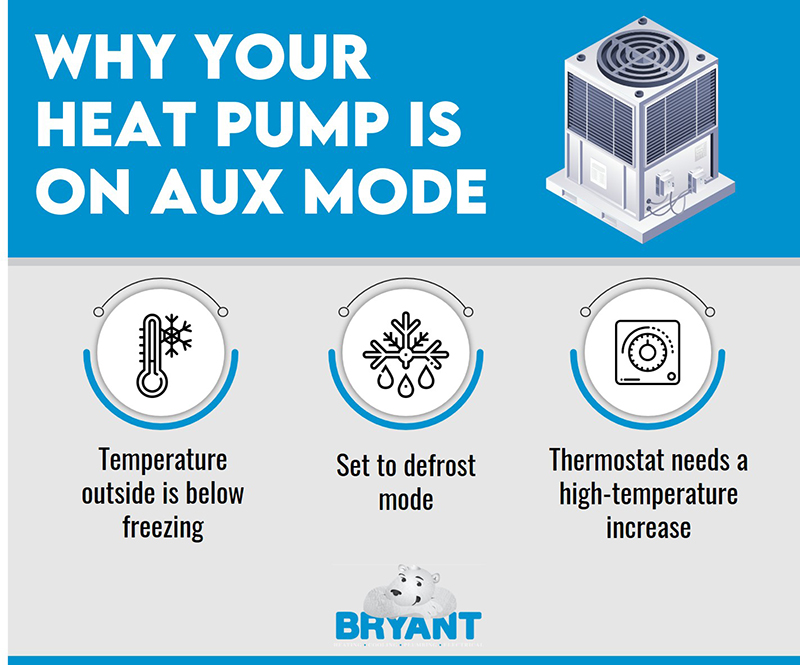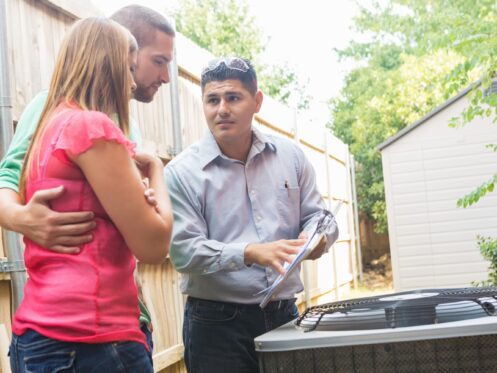Do you have a heat pump and have recently noticed your thermostat is showing Aux or Aux Heat mode? Any time your thermostat shows your heating system is running in auxiliary mode, it just means the auxiliary heating is running. This is usually nothing you need to worry about, but there are times when it can indicate a problem with your heat pump. Here, we’ll explain all you need to know about the auxiliary heating mode on a heat pump system. We will also explain how to know when your system running on auxiliary mode is a sign of a problem.
What Is Aux Heat Mode on a Heat Pump System?
In a cold climate, any heat pump system requires a secondary or auxiliary source of heat that will run at specific times. This auxiliary heat source is necessary for several different reasons. The main one is that a heat pump always eventually freezes up when operating in colder temperatures, leading to it then needing to defrost. If it didn’t defrost, the layer of ice on its coil would prevent it from being able to capture heat and pump it out into the house.
The issue is that the only way a heat pump can defrost is by switching from heating to cooling mode. This enables the refrigerant in the system to capture heat from within the house so that hot refrigerant gets pumped through the outdoor coil to melt all of the ice. Most heat pump systems have electric heat strips within the air handler inside the house that serve as the auxiliary heating. If these strips didn’t come on and start pumping out heat when the heat pump is defrosting, you’d end up with the temperature in the house quickly dropping. This is because the system actively draws heat out of the house when defrosting.
Another reason an auxiliary source is necessary is that there can just be times when it gets too cold outside for the heat pump to work. The final reason is that heat pumps don’t heat all that quickly. That’s why the auxiliary source will also kick in and run alongside the heat pump anytime the system needs to raise the temperature by more than a couple of degrees.
How to Know When Aux Heat Mode Is Potentially a Sign of a Problem
Your thermostat will also always show the system is in auxiliary mode during each defrost cycle. Some heat pumps just have a timer and will automatically switch to defrost mode at set intervals, such as every 45 or 90 minutes. Other units instead have an internal sensor that monitors how cold the outdoor coil is and signals the heat pump to defrost when the coil drops below a certain temperature. In either case, it will normally take no more than 15 minutes for the coil to defrost and the heat pump to switch back to heating mode.

The time when you need to be concerned is if your thermostat registers that your home is at or close to the correct temperature. Then, it continues to display the system is in auxiliary mode for more than 30 minutes or so. In this case, the first thing to do is go outside and see if your heat pump is actually running and whether it has lots of ice built up inside it. If the unit isn’t running, it indicates there’s an issue such as an electrical problem or a failed capacitor that is preventing it from turning. In this case, the auxiliary heating will continuously run as much as needed since it also serves as the backup heat source should an issue like this arise.
If there is a large amount of ice on the heat pump but it’s still running, you should wait another hour or so to see if it finally defrosts. One issue that can happen if a heat pump’s defrost mode runs on a timer is that it may not run often enough when the temperature is much colder. This can lead to so much ice building up that it takes far longer before everything finally melts.
If your heat pump continues running and is still frozen after several hours, it’s definitely time to call an HVAC company for an emergency inspection by a licensed heating services provider. This isn’t something you want to put off since the auxiliary heat strips use many times more electricity than the heat pump. That means your heating bills can end up skyrocketing if you have to rely solely on the auxiliary heating for very long.
Members save on service. Join our Whole Home Care Plan today!
What Can Prevent a Heat Pump From Defrosting?
There are a few different reasons why a heat pump may fail to fully defrost when frozen. The most common reason is that the unit’s reversing valve is broken or stuck. This valve is what allows a heat pump to switch back and forth between cooling and heating modes. It’s fairly common for a reversing valve to break during the winter since it has to activate so many times a day to switch the system to defrost mode.
If it does break or get stuck, it can result in the heat pump remaining in heating mode and never being able to defrost. That means it will run continuously without putting out any heat as a result of the coil being frozen. It also results in the auxiliary heating coming on fairly soon and running fairly frequently to prevent the temperature in the house from getting too cold.
Another potential is that there’s a leak in the system and it no longer has enough refrigerant to work correctly. The issue if the refrigerant charge is low is that it leads to a drop in pressure, which in turn causes the temperature of the refrigerant to remain much lower than it should. This is why one of the first things a technician will do when diagnosing why your heat pump won’t defrost is check the level of the refrigerant charge.
If the charge is low, they’ll then have to inspect the indoor coil, the outdoor coil and the copper lines to find where the leak is. Once they’ve located the leak, they’ll then need to drain and capture the refrigerant before they can fix the issue. If there’s just a small leak in one of the copper lines, the technician may be able to patch it or just replace that section. A leak in one of the coils is a much more expensive heat pump repair since the only option in this situation is to replace the entire coil.
Contact Us Today
Bryant Heating, Cooling, Plumbing & Electric is the leading home service company in Kentucky, Ohio and Indiana, and we have more than 80 years of experience providing reliable heating, cooling, plumbing and electrical services. We have locations in Bowling Green, Cincinnati, Louisville, Lexington and Evansville, and our team is ready to help ensure your home comfort needs are fully met with heat pump installation, maintenance, and more.
If you’re experiencing any issues with a heat pump, furnace, or AC, give us a call and let one of our experts quickly get to the bottom of the issue.



